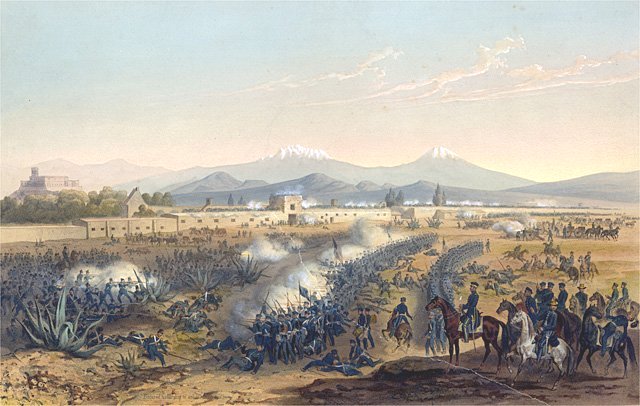Few men experienced such heroic military service in the 19th century as did William Trousdale of Tennessee.
Riddled with battle scars by the time of his death in March, 1872, the backwoodsman would earn the nickname “Sumner County’s War Horse” after fighting against Creek and Seminole Indians and British and Mexican soldiers for over 30 years of service. Trousdale served under the immortal Andrew Jackson, and declined an generalship from the legendary leader saying, “I value the compliment, but decline the appointment, as I desire no connection with the army except in times of war.”

William Trousdale was born in North Carolina on September 23, 1790. At the age of 6, his father James — a Scotch-Irish officer who served under Gen. George Washington — emigrated with his family from North Carolina to Tennessee after the American Revolution. In the uncompromising landscape of the Tennessee frontier, young Trousdale matured into adulthood “amid the trying experiences of rude pioneer life,” and became familiar “with privation and inured to hardship.” Despite his Spartan upbringing, he proved to be an excellent student, pouring over history books, biographies, and Shakespeare’s dramas.
His first call to arms came in 1813. At 23, he volunteered for service as a private in Capt. William Edwards’ company in the Second Regiment of Volunteer Mounted Riflemen and fought at the Battles of Tallushatchee (Davy Crockett also fought there) and Talladega under Andrew Jackson during the Red Stick Creek War. In one incident shortly after he received a promotion to lieutenant, Trousdale traversed the rushing and high currents of the Tennessee River on horseback, on a special mission from Jackson, despite the fact he could not swim and nearly up to his waist in water. He journeyed in this manner for nearly three miles until he completed his daring mission.
Trousdale returned home soon after, but was thrust back into war when the British burned the U.S. capital in August of 1814. He rejoined his regiment under Jackson in November of 1814, and marched to Pensacola, Florida, as part of the American expedition attempting to drive out a unified Britain, Spanish, and Creek Indian detachment. When a single gun positioned in the city’s street threatened to decimate the American ranks, Trousdale “with several other daring spirits,” charged the gun head-on and captured it.
Fort San Miguel still held out and a forlorn assault was prepared for the next day. A call was made for volunteers, and not a man stepped forward dreading the task of marching into the “very jaws of certain death.” Trousdale suddenly “broke the silence by proclaiming himself ready for the assault” and stepped forward, leading others to follow his bold example. Fortunately for the Americans, the British evacuated the fort the next day removing the need for a frontal assault.
Jackson’s command moved to New Orleans from Pensacola when a British expedition prepared to make an amphibious landing near the city. There Trousdale fought as one of the many motley Americans who defended the city of New Orleans against a professionally trained British invasion force in January of 1815.
Trousdale returned to Tennessee and resumed the study of law. Admitted to the bar in 1820, he also chose to enter politics, but the Second Seminole War interrupted his civilian pursuits. He was soon elected colonel of the Second Regiment of Tennessee Mounted Volunteers and led a storming party over a heavily defended hammock at the Battle of Wahoo Swamp in November of 1836.
During the action it was recorded that, “Colonel Trousdale vainly attempted to force his horse through the closely matted vines and shrubbery, and in the midst of a terrific shower of rifle balls leaped from his horse, seized his holsters, and on foot bade his command ‘follow him.’ They did follow him and, hand to hand, struggled with the foe in the hammock and came out victorious.”
When war broke out with Mexico 10 years later, he received an appointment as colonel of the newly organized Fourteenth Infantry Regiment from President James K. Polk. He led his regiment at the Battles of Contreras and Churubusco outside of Mexico City in August of 1847.

At the bloody Battle of Molino del Rey on September 8, a Mexican bullet pierced Trousdale’s shoulder, and he also had his horse shot from under him. Despite his minor wound, Trousdale led his regiment in the assault on Chapultepec Castle four days later. He received two more wounds in the right arm in this battle, but refused to leave the field, and only allowed the wound to be treated after an American victory had been secured. He received praise after the war from President Polk for his “gallant and meritorious conduct in the battle of Chapultepec,” and was brevetted a brigadier general.
Following the conflict, he served as the governor of Tennessee and as a minister to Brazil. He died at the age of eighty-one years old of pneumonia on March 27, 1872, ending a long and illustrious career volunteering his services to his home state and country.
Trousdale’s exploits remain unknown to most Americans today. Upon his death, the Fayetteville Observer made a proclamation that may still hold true even 140 years later: “While the past generation revere his reputation, the rising youth may find his virtues a study; in his acts, an example worthy of imitation.”


